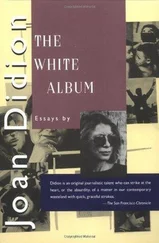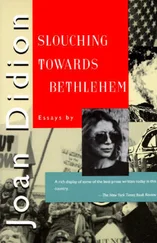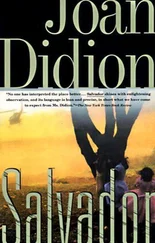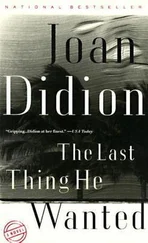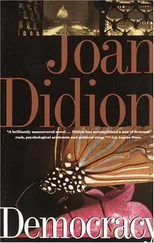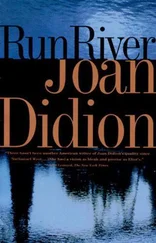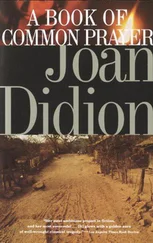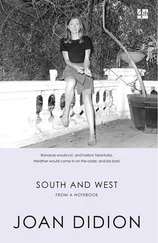This is interesting, a quite naked expression of what has been the California conundrum. Scaled against Yosemite, or against the view through the Gate of the Pacific trembling on its tectonic plates, the slightest shift of which could and with some regularity did destroy the works of man in a millisecond, all human beings were of course but as worms, their “heroic imperatives” finally futile, their philosophical inquiries vain. The population of California has increased in my lifetime from six million to close to thirty-five million people, yet the three phrases that come first to mind when I try to define California to myself refer exclusively to its topography, a landscape quite empty of people. The first of these phrases comes from the language of broadcast weather reports, the second from John Muir. The third, and most persistent, comes from Robinson Jeffers. Point Conception to the Mexican border. The Range of Light. Beautiful country burn again, / Point Pinos down to the Sur Rivers.
This is the point in the California experience when discussion stops, and many voices fade. Broadcast weather reports could be seen as nominally neutral on the question of whether human beings have any rightful place in California, but John Muir and Robinson Jeffers could not. Muir traded the Calvinism of his Scottish childhood for an equally Calvinist wilderness, a landscape in which he could tolerate only Indians, because Indians “walk softly and hurt the landscape hardly more than the birds and squirrels, and their brush and bark huts last hardly longer than those of woodrats, while their more enduring monuments, excepting those wrought on the forests by the fires they made to improve their hunting grounds, vanish in a few centuries.” Jeffers tolerated no one at all, taking this aversion to the point at which he came to favor war, which alone, as he saw it, could return the world to its “emptiness,” to “the bone, the colorless white bone, the excellence.” “Be in nothing so moderate as in love of man,” he advised his twin sons, and referred to mankind as a “botched experiment that has run wild and ought to be stopped.” He was accused of “proto-fascism.” He called himself an “Inhumanist.” (As in, from a posting on the Jeffers Studies web site, “I’m interested in the relationship between Inhumanism and Deep Ecology and would welcome any thoughts or comments.”) He seemed to many an easy target: his poetry could be pretentious, his postures ugly. Read in situ, however, Jeffers makes fatally seductive sense: Burn as before with bitter wonders, land and ocean and the Carmel water. And: When the cities lie at the monster’s feet there are left the mountains.
I am thinking and writing face to face with a mighty and lovely Nature , Josiah Royce wrote, by the side of whose greatness I am but as a worm. Royce in fact seems to have maintained an exhausting but finally vain alert against the undertow of this localized nihilism. His 1886 California: A Study of American Character bore on its title page these peculiar but premonitory lines, spoken by Mephistopheles in the Prologue to Faust: On suns and worlds I can shed little light I see but humans, and their piteous plight. At sixty, in despair at the prospect of World War One and a few months short of what would be a fatal stroke, he encountered in Harvard Yard one of his students, Horace Kallen, who, according to Robert V. Hine’s Josiah Royce: From Grass Valley to Harvard , reported of Royce that “When I greeted him, his round blue eyes looked staring, and without recognition. And then he said in a voice somehow thinner … ‘You are on the side of humanity, aren’t you?’” A few months before, describing himself as “socially ineffective as regards genuine ‘team play,’ ignorant of politics, an ineffective member of committees, and a poor helper of concrete social enterprises,” as well as “a good deal of a non-conformist, and disposed to a certain rebellion,” Royce had acknowledged that the idea of community to which he had devoted his career remained in some way alien to him: “When I review this whole process, I strongly feel that my deepest motives and problems have centered about the Idea of the Community, although this idea has only come gradually to my clear consciousness. This is what I was intensely feeling, in the days when my sisters and I looked across the Sacramento Valley, and wondered about the great world beyond our mountains.… So much of the spirit that opposes the community I have and have always had in me, simply, deeply, elementally.”
So much of the spirit that opposes the community: of course he had it in him, considering what he was: “… because I am a Californian ,” he himself had written, “as little bound to follow mere tradition. …” In 1970 I spent a month in the South, in Louisiana and Alabama and Mississippi, under the misapprehension that an understanding of the differences between the West and the South, which had given California a good deal of its original settlement, would improve my understanding of California. Royce had fretted over the same question: “Very early … this relatively peaceful mingling of Americans from North and South had already deeply affected the tone of California life,” he noted in California: A Study of American Character. “The type of the Northern man who has assumed Southern fashions, and not always the best Southern fashions at that, has often been observed in California life…. He often followed the Southerner, and was frequently, in time, partly assimilated by the Southern civilization.” One difference between the West and the South, I came to realize in 1970, was this: in the South they remained convinced that they had bloodied their land with history. In California we did not believe that history could bloody the land, or even touch it.
THOMAS KINKADE was born in the late 1950s and raised in Placerville, El Dorado County, where his mother supported him and his siblings by working as a notary public, piecework, five dollars a document. The father had left. The family lived much of the time in a trailer. By the early 1990s “Thomas Kinkade” was a phenomenon, a brand on his own, a merchandiser who could touch a snow globe or a stoneware mug or a night-light or a La-Z-Boy chair with the magic of his name and turn it to money, a painter so successful that by the end of the decade there would be throughout the United States 248 Thomas Kinkade “signature galleries,” seventy-eight of them in California alone, most of those in malls or tourist areas, four for example in Monterey and another four in Carmel, two exits down Highway 1. Since very few of Thomas Kinkade’s original oil paintings were by that time available, and since those that were had risen in price from about $15,000 in the early 1990s to more than $300,000 by 1997, the pictures sold in these 248 “signature galleries” were canvas-backed reproductions, which themselves sold for $900 to $15,000 and were produced by the 450 employees who labored in the hundred-thousand-square-foot Morgan Hill headquarters of Media Arts Group Incorporated (“MDA” on the New York Stock Exchange), the business of which was Thomas Kinkade.
The passion with which buyers approached these Kinkade images was hard to define. The manager of one California gallery that handled them told me that it was not unusual to sell six or seven at a clip, to buyers who already owned ten or twenty, and that the buyers with whom he dealt brought to the viewing of the images “a sizeable emotional weight.” A Kinkade painting was typically rendered in slightly surreal pastels. It typically featured a cottage or a house of such insistent coziness as to seem actually sinister, suggestive of a trap designed to attract Hansel and Gretel. Every window was lit, to lurid effect, as if the interior of the structure might be on fire. The cottages had thatched roofs, and resembled gingerbread houses. The houses were Victorian, and resembled idealized bed-and-breakfasts, at least two of which in Placerville, the Chichester-McKee House and the Combellack-Blair House, claimed to have been the models for Kinkade “Christmas” paintings. “There’s a lot of beauty here that I present in a way that’s whimsical and charming,” Kinkade allowed to the Placerville Mountain Democrat. He branded himself the “Painter of Light,” and the postcards Media Arts provided to his galleries each for a while bore this legend: “Thomas Kinkade is recognized as the foremost living painter of light. His masterful use of soft edges and luminous colors give his highly detailed oil paintings a glow all their own. This extraordinary ‘Kinkade Glow’ has created an overwhelming demand for Thomas Kinkade paintings and lithographs worldwide.”
Читать дальше
Конец ознакомительного отрывка
Купить книгу



